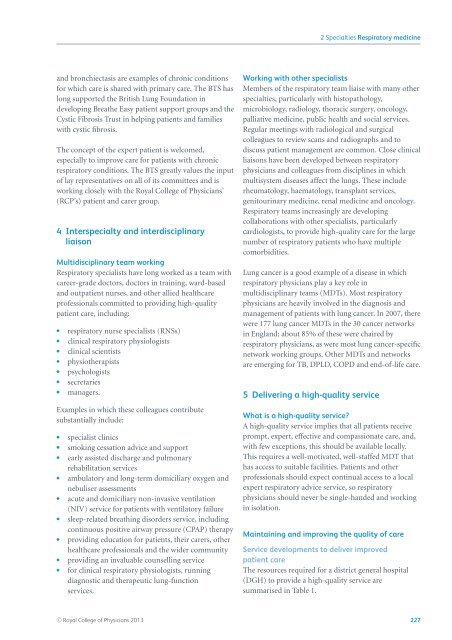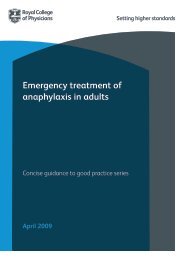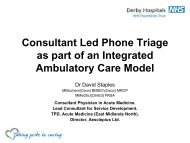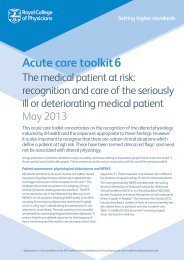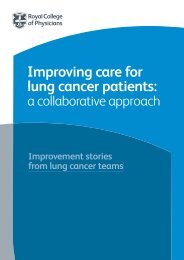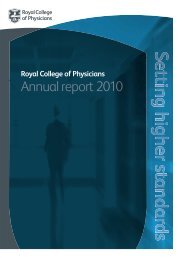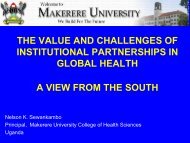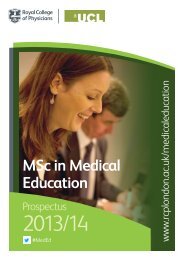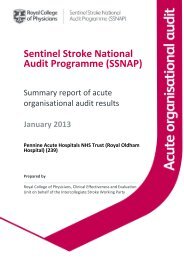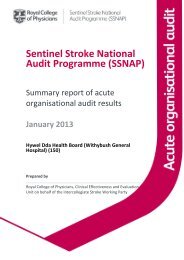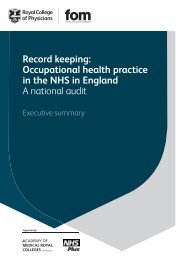Consultant physicians working with patients - Royal College of ...
Consultant physicians working with patients - Royal College of ...
Consultant physicians working with patients - Royal College of ...
You also want an ePaper? Increase the reach of your titles
YUMPU automatically turns print PDFs into web optimized ePapers that Google loves.
2 Specialties Respiratory medicineand bronchiectasis are examples <strong>of</strong> chronic conditionsfor which care is shared <strong>with</strong> primary care. The BTS haslong supported the British Lung Foundation indeveloping Breathe Easy patient support groups and theCystic Fibrosis Trust in helping <strong>patients</strong> and families<strong>with</strong> cystic fibrosis.The concept <strong>of</strong> the expert patient is welcomed,especially to improve care for <strong>patients</strong> <strong>with</strong> chronicrespiratory conditions. The BTS greatly values the input<strong>of</strong> lay representatives on all <strong>of</strong> its committees and is<strong>working</strong> closely <strong>with</strong> the <strong>Royal</strong> <strong>College</strong> <strong>of</strong> Physicians’(RCP’s) patient and carer group.4 Interspecialty and interdisciplinaryliaisonMultidisciplinary team <strong>working</strong>Respiratory specialists have long worked as a team <strong>with</strong>career-grade doctors, doctors in training, ward-basedand outpatient nurses, and other allied healthcarepr<strong>of</strong>essionals committed to providing high-qualitypatient care, including: respiratory nurse specialists (RNSs) clinical respiratory physiologists clinical scientists physiotherapists psychologists secretaries managers.Examples in which these colleagues contributesubstantially include: specialist clinics smoking cessation advice and support early assisted discharge and pulmonaryrehabilitation services ambulatory and long-term domiciliary oxygen andnebuliser assessments acute and domiciliary non-invasive ventilation(NIV) service for <strong>patients</strong> <strong>with</strong> ventilatory failure sleep-related breathing disorders service, includingcontinuous positive airway pressure (CPAP) therapy providing education for <strong>patients</strong>, their carers, otherhealthcare pr<strong>of</strong>essionals and the wider community providing an invaluable counselling service for clinical respiratory physiologists, runningdiagnostic and therapeutic lung-functionservices.Working <strong>with</strong> other specialistsMembers <strong>of</strong> the respiratory team liaise <strong>with</strong> many otherspecialties, particularly <strong>with</strong> histopathology,microbiology, radiology, thoracic surgery, oncology,palliative medicine, public health and social services.Regular meetings <strong>with</strong> radiological and surgicalcolleagues to review scans and radiographs and todiscuss patient management are common. Close clinicalliaisons have been developed between respiratory<strong>physicians</strong> and colleagues from disciplines in whichmultisystem diseases affect the lungs. These includerheumatology, haematology, transplant services,genitourinary medicine, renal medicine and oncology.Respiratory teams increasingly are developingcollaborations <strong>with</strong> other specialists, particularlycardiologists, to provide high-quality care for the largenumber <strong>of</strong> respiratory <strong>patients</strong> who have multiplecomorbidities.Lung cancer is a good example <strong>of</strong> a disease in whichrespiratory <strong>physicians</strong> play a key role inmultidisciplinary teams (MDTs). Most respiratory<strong>physicians</strong> are heavily involved in the diagnosis andmanagement <strong>of</strong> <strong>patients</strong> <strong>with</strong> lung cancer. In 2007, therewere 177 lung cancer MDTs in the 30 cancer networksin England; about 85% <strong>of</strong> these were chaired byrespiratory <strong>physicians</strong>, as were most lung cancer-specificnetwork <strong>working</strong> groups. Other MDTs and networksare emerging for TB, DPLD, COPD and end-<strong>of</strong>-life care.5 Delivering a high-quality serviceWhat is a high-quality service?A high-quality service implies that all <strong>patients</strong> receiveprompt, expert, effective and compassionate care, and,<strong>with</strong> few exceptions, this should be available locally.This requires a well-motivated, well-staffed MDT thathas access to suitable facilities. Patients and otherpr<strong>of</strong>essionals should expect continual access to a localexpert respiratory advice service, so respiratory<strong>physicians</strong> should never be single-handed and <strong>working</strong>in isolation.Maintaining and improving the quality <strong>of</strong> careService developments to deliver improvedpatient careThe resources required for a district general hospital(DGH) to provide a high-quality service aresummarised in Table 1.C○ <strong>Royal</strong> <strong>College</strong> <strong>of</strong> Physicians 2013 227


